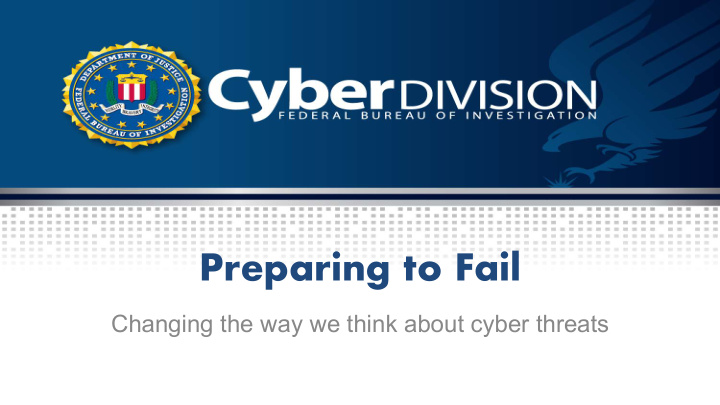



Preparing to Fail Changing the way we think about cyber threats
Oil Rig Pic
Flaming Oil Rig picture
The asymmetric nature of the Internet
The current state of cyber underground
Our current approach
UNCLASSIFIED 7
Software Integrity Denial of Service UNCLASSIFIED 8
Specific threats to the Packaging Industry • Ransomware
Ransomware
Business Email Compromise
Primary Schemes Name Scheme Supplier The “supplier” changes receiving bank Swindle accounts CEO Fraud The “CEO” requests an payment for an acquisition or service Shipping The “receiver” requests a change in Switch-up shipping destination 3 rd Party The “3 rd Party” service requests payment for services rendered Data theft Important data is requested for use in tax fraud UNCLASSIFIED 12
BEC examples UNCLASSIFIED 13
We must… • Understand the threats to our company • Design specific mitigation and recovery controls into our business process
Ransomware 1.Implement the technical controls within email 2.Un-flatten our networks – everyone does not need access to everything in your network 3.Back up, virtualize, and TEST recovery 4.Don’t immediately destroy the infected system 5.Explore the payment mechanism
Business email compromise 1. Implement technical controls in email such as [external] tags, webmail auditing 2. Two-factor authentication / Password re-use*** 3. Educate the specific departments that are often targeted – C-Level, Finance, Human Resources, Sales, Shipping 4. Design controls that allow for failure –Processes for shipping, payments, acquisitions, employee information 5. Engage your 3 rd parties, such as banks, consultants, law firms 6. Know who to call when failure happens, have a team in place
Other considerations • Cyber insurance • 3 rd parties –Processes –Communication –Responsibilities • Managed services • Incident Response on retainer • Practice responding to incidents with the entire team UNCLASSIFIED 17
Key Take Aways • If you only remember two things from my presentation, they should be… 1. Failure will happen 2. Failure doesn’t equal disaster, mishandling failure most likely will. • When you get back to your office, the two things you should do are… 1. Design your processes and relationships to mitigate failure 2. Practice your response
Recommend
More recommend